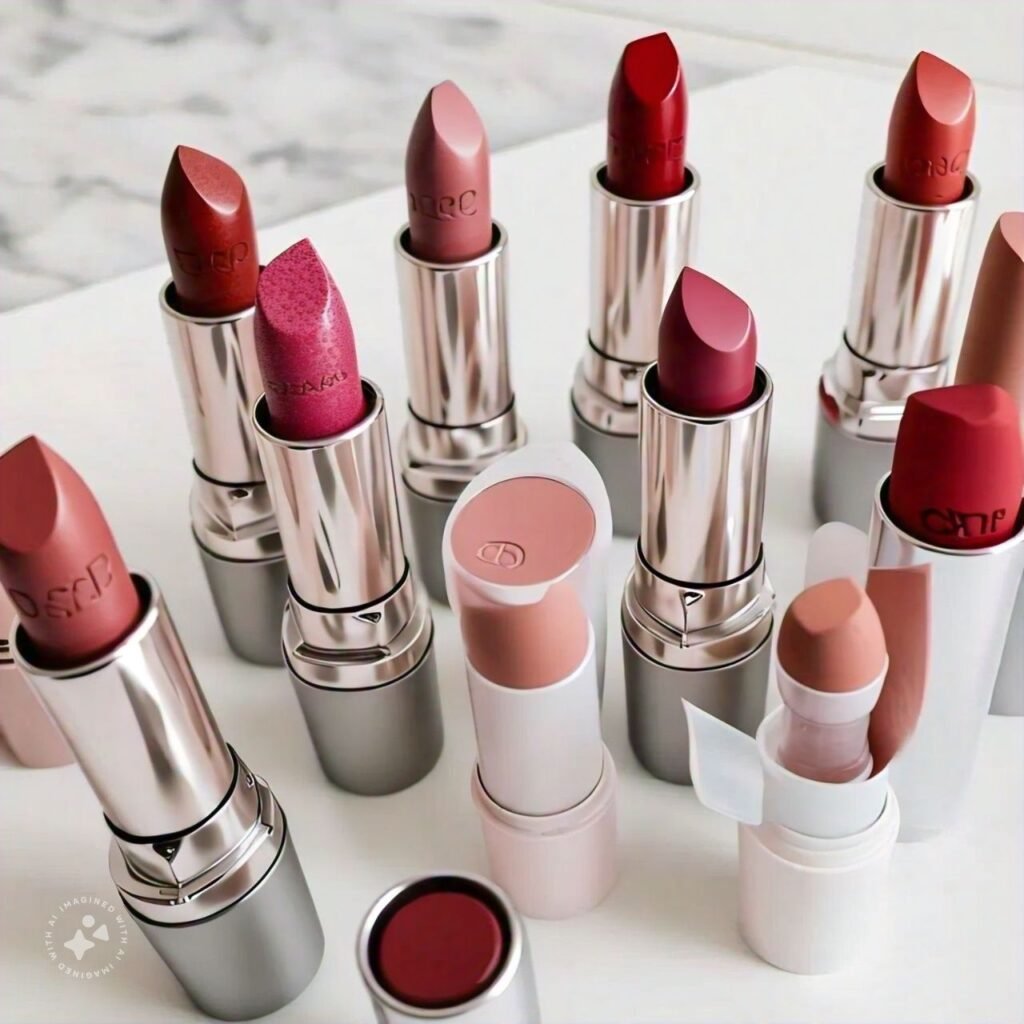Lipsticks are complex cosmetic products that combine multiple ingredients to provide color, texture, and protection to the lips. The process of making lipstick involves combining waxes, oils, pigments, and other ingredients to achieve a smooth, even consistency that is easy to apply and long-lasting. Here’s a breakdown of the main components and the manufacturing process:
Waxes



Waxes are used to give structure and shape to the lipstick. They allow the lipstick to glide smoothly over the lips without being too soft. The main types of waxes used include:
- Beeswax: Natural wax secreted by honeybees, giving a firm texture.
- Carnauba Wax: A hard, plant-based wax from the leaves of the Brazilian palm tree.
- Candelilla Wax: Another plant-based wax, often used to replace beeswax in vegan lipsticks.
- Paraffin Wax: A petroleum-based wax that helps in molding and hardening.
Oils and Fats
Oils provide moisture, smoothness, and a creamy texture, making lipstick easier to apply. They help with blending the pigments and prevent lips from drying out. Common oils used are:
- Castor Oil: A thick oil that adds shine and smoothness.
- Lanolin: Derived from sheep’s wool, it acts as a moisturizing agent.
- Cocoa Butter or Shea Butter: Both provide a creamy texture and nourishing properties.
- Mineral Oil or Petrolatum: Petroleum derivatives that help lock in moisture and prevent drying.
Pigments
Pigments give the lipstick its color. There are different types of pigments and dyes used in lipsticks:
- Organic Pigments: Derived from plants or synthesized in labs, providing vibrant shades.
- Inorganic Pigments: Such as iron oxides and titanium dioxide, often used for creating neutral and earthy tones.
- Dyes: Water or oil-soluble colorants that provide brighter, more intense shades.
- Pearlescent Pigments (Mica): These give a shimmery or glossy finish by reflecting light.
Emollients and Moisturizers
These ingredients are added to keep the lips hydrated and soft. They help prevent the lipstick from drying out the lips, making it comfortable to wear for longer periods:
- Vitamin E: A popular antioxidant and skin conditioner.
- Aloe Vera or Jojoba Oil: These natural moisturizers help soothe and protect the lips.
Preservatives
Preservatives are used to prevent the growth of bacteria, mold, and yeast in the lipstick, ensuring a longer shelf life. Some common preservatives are:
- Parabens: Widely used in cosmetics, though they have become controversial due to health concerns.
- Phenoxyethanol: An alternative to parabens.
- BHT (Butylated Hydroxytoluene): An antioxidant that helps preserve oils and fats in the lipstick.
Fragrance and Flavoring Agents
Many lipsticks have added fragrance or flavor to make them more appealing. These can be synthetic or derived from natural sources.
UV Filters
Some lipsticks contain UV filters to protect the lips from sun damage. Ingredients like octinoxate or titanium dioxide are used for this purpose.
2. Manufacturing Process of Lipstick


1. Melting and Mixing
- The waxes (beeswax, carnauba, candelilla) are first melted together in large tanks at a specific temperature to form the base.
- The oils and fats (like castor oil, lanolin, or shea butter) are then added to the melted wax mixture.
- Pigments are separately ground into a fine powder and mixed with some of the oil to form a color paste.
- The color paste is then blended into the wax and oil mixture.
2. Molding
- Once the ingredients are fully mixed and homogenized, the mixture is heated until it becomes a liquid.
- The liquid lipstick mixture is then poured into molds to give it the iconic lipstick shape.
- The molds are cooled, often using refrigeration or air cooling methods, so the lipstick hardens and solidifies.
3. Flaming and Finishing
- After the lipstick is removed from the molds, it is passed through a process called flaming, where a controlled flame is passed over the lipstick to give it a smooth, glossy surface.
- Some lipsticks may be further polished or even coated to ensure the final product has an appealing texture and appearance.
4. Packaging
- Finally, the lipsticks are inserted into their tubes or casings, which are usually plastic or metal.
- The packaging is then sealed and labeled, ready for sale.
3. Types of Lipsticks



Different types of lipsticks are made based on variations in ingredients and formulas:
- Matte Lipsticks: Contain less oil and more wax, providing a flat, non-glossy finish.
- Cream Lipsticks: Have a balance of oils and waxes, providing a smooth texture with a slight shine.
- Gloss Lipsticks: Have a higher concentration of oils, giving a shiny, wet look.
- Long-Wearing Lipsticks: May include silicone-based ingredients that help the lipstick adhere to lips for extended periods without smudging.
4. Lipstick Innovations


Modern lipstick formulations include additional features, such as:
- Hydrating Formulas: With ingredients like hyaluronic acid to prevent lips from drying.
- Vegan and Cruelty-Free: Using plant-based waxes and oils, avoiding animal-derived ingredients.
- Sustainability: Some companies are focusing on using eco-friendly and biodegradable packaging.
Conclusion
Lipsticks are a blend of waxes, oils, pigments, and emollients that are carefully formulated to deliver color, moisture, and a desired texture to the lips. The balance between these ingredients and the manufacturing process determines the quality, finish, and longevity of the product.



